
The early bumblebee or early-nesting bumblebee is a small bumblebee with a wide distribution in most of Europe and parts of Asia. It is very commonly found in the UK and emerges to begin its colony cycle as soon as February which is earlier than most other species, hence its common name. There is even some evidence that the early bumblebee may be able to go through two colony cycles in a year. Like other bumblebees, Bombus pratorum lives in colonies with queen and worker castes. Bombus pratorum queens use aggressive behavior rather than pheromones to maintain dominance over the workers!

Bombus lapidarius is a species of bumblebee in the subgenus Melanobombus. Commonly known as the red-tailed bumblebee, B. lapidarius can be found throughout much of Central Europe. Known for its distinctive black and red body, this social bee is important in pollination.

Bombus vestalis, the vestal cuckoo bumblebee, is a species of cuckoo bumblebee that lives in most of Europe, as well as North Africa and western Asia. It is a brood parasite that takes over the nests of other bee species. Its primary host is Bombus terrestris. After its initial classification as Psithyrus vestalis, this bumblebee recently was reclassified into the genus Bombus, subgenus Psithyrus.

Bombus campestris is a very common cuckoo bumblebee found in most of Europe.
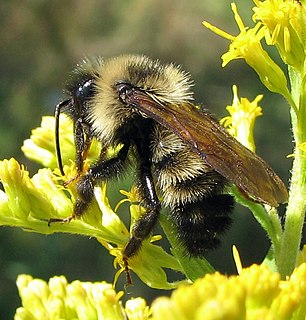
Bombus citrinus is a species of bumblebee known commonly as the lemon cuckoo bumblebee due to its lemon-yellow color. It is native to eastern North America.
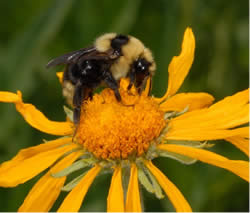
Bombus insularis is a species of bumblebee in the subgenus Psithyrus, the cuckoo bumblebees. It is native to northern and western North America, where it occurs throughout Canada, Alaska, the northern United States, and some western states. It is known commonly as the indiscriminate cuckoo bumblebee.
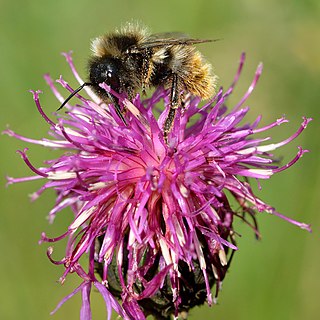
Bombus rupestris is a species of cuckoo bumblebee present in most of Europe except Iceland. In the Balkans it is found in montane and alpine habitats northwards from Central Greece. It is also found in Turkey.

Bombus sylvestris, known as the forest cuckoo bumblebee or four-coloured cuckoo bee, is a species of cuckoo bumblebee, found in most of Europe and Russia. Its main hosts are Bombus pratorum, Bombus jonellus, and Bombus monticola. As a cuckoo bumblebee, Bombus sylvestris lays its eggs in another bumblebee's nest. This type of bee leaves their young to the workers of another nest for rearing, allowing cuckoo bumblebees to invest minimal energy and resources in their young while still keeping the survival of their young intact.
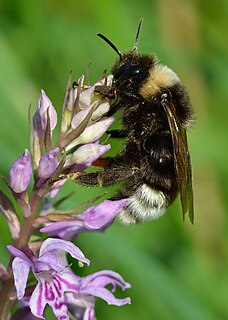
Bombus bohemicus, also known as the gypsy's cuckoo bumblebee, is a species of socially parasitic cuckoo bumblebee found in most of Europe with the exception of the southern Iberian Peninsula and Iceland. B. bohemicus practices inquilinism, or brood parasitism, of other bumblebee species. B. bohemicus is a generalist parasite, successfully invading several species from genus Bombus. The invading queen mimics the host nest's chemical signals, allowing her to assume a reproductively dominant role as well as manipulation of host worker fertility and behavior.

The broken-belted bumblebee or Ilfracombe bumblebee, Bombus soroeensis, is a species of bumblebee present in most of Europe and parts of Asia.

Bombus monticola, the bilberry bumblebee, blaeberry bumblebee or mountain bumblebee, is a species of bumblebee found in Europe.

The heath humble-bee or small heath bumblebee, Bombus jonellus, is a species of bumblebee, widely distributed in Europe and northern Asia, as well as northern North America.
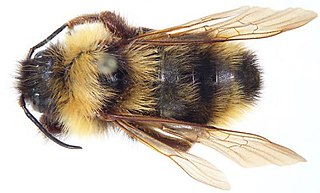
Bombus suckleyi is a species of bumblebee known commonly as Suckley's cuckoo bumblebee, named after biologist George Suckley. Suckley's bumble bee is a generalist pollinator and represents a rare group of obligate, parasitic bumble bees. Suckley's bumble bee is a social-parasite because it invades the nests of the host bumble bees, including the western bumble bee, and relies on host species workers to provision its larvae. It is native to northwestern North America, including Alaska and parts of western and central Canada and the western United States.

Bombus lucorum, the white-tailed bumblebee, is a species of bumblebee, widespread and common throughout Europe. This name has been widely used for a range of nearly identical-looking or cryptic species of bumblebees. In 1983, Scholl and Obrecht even coined the term Bombus lucorum complex to explain the three taxa that cannot be easily differentiated from one another by their appearances. A recent review of all of these species worldwide has helped to clarify its distribution in Europe and northern Asia, almost to the Pacific. B. lucorum reaches the Barents Sea in the North. However, in southern Europe, although found in Greece it is an upland species with its distribution never quite reaching the Mediterranean.
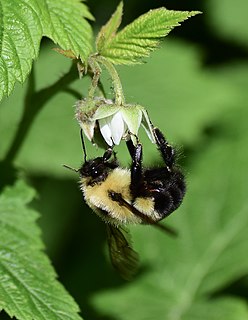
The two-spotted bumble bee is a species of social bumble bee found in the eastern half of the United States and the adjacent south-eastern part of Canada. In older literature this bee is often referred to as Bremus bimaculatus, Bremus being a synonym for Bombus. The bee's common name comes from the two yellow spots on its abdomen. Unlike many of the other species of bee in the genus Bombus,B. bimaculatus is not on the decline, but instead is very stable. They are abundant pollinators that forage at a variety of plants.

Bombus fervidus, the golden northern bumble bee or yellow bumblebee, is a species of bumblebee native to North America. It has a yellow-colored abdomen and thorax. Its range includes the North American continent, excluding much of the southern United States, Alaska, and the northern parts of Canada. It is common in cities and farmland, with populations concentrated in the Northeastern part of the United States. It is similar in color and range to the American bumblebee. It has complex behavioral traits, which includes a coordinated nest defense to ward off predators. B. fervidus is an important pollinator, so recent population decline is a particular concern.
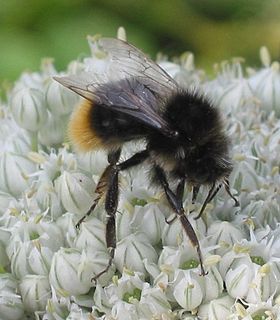
Bombus ruderarius, commonly known as the red-shanked carder bee or red-shanked bumblebee, is a species of bumblebee found in Eurasia.

The apple humble-bee or apple bumblebee is a species of bumblebee.

Bombus flavifrons, the yellow-fronted bumble bee or yellowhead bumblebee, is a species of bumblebee. It is native to North America, where it is distributed across much of Canada, Alaska, and the western contiguous United States.
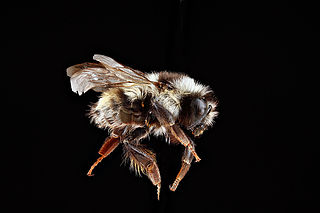
Bombus vancouverensis is a common species of eusocial bumblebee of the subgenus Pyrobombus. B. vancouverensis inhabits mountainous regions of western North America, where it has long been considered as a synonym of Bombus bifarius, and essentially all of the literature on bifarius refers instead to vancouverensis. B. vancouverensis has been identified as one of the two species of bumblebee observed to use pheromones in kin recognition. The other is the frigid bumblebee, Bombus frigidus.






















